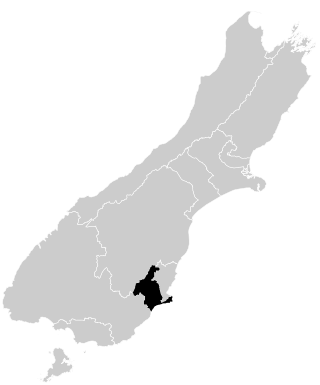Top Qs
Timeline
Chat
Perspective
Dunedin South
Former electorate in Otago, New Zealand From Wikipedia, the free encyclopedia
Remove ads
Dunedin South is a former New Zealand parliamentary electorate. It first existed from 1881 to 1890, and subsequently from 1905 to 1946. In 1996, the electorate was re-established for the introduction of MMP, before being abolished in 2020.

Population centres
Summarize
Perspective
The previous electoral redistribution was undertaken in 1875 for the 1875–1876 election. In the six years since, New Zealand's European population had increased by 65%. In the 1881 electoral redistribution, the House of Representatives increased the number of European representatives to 91 (up from 84 since the 1875–76 election). The number of Māori electorates was held at four. The House further decided that electorates should not have more than one representative, which led to 35 new electorates being formed, including Dunedin South, and two electorates that had previously been abolished to be recreated. This necessitated a major disruption to existing boundaries.[1]
As the name suggests, the electorate was based on the southern suburbs of Dunedin. It stretched out westwards to take in towns on the Taieri Plains such as Mosgiel, Green Island and Fairfield. The Otago Peninsula was also in the electorate.
The most recent Dunedin South electorate was created in 1996 as one of the original 65 MMP electorates, as a merger between St Kilda and a large part of Dunedin West. Until the 2008 election, it was enlarged at every electoral boundary review, but in the 2013 review, its boundaries were kept.[2] Middlemarch was first included in the electorate for the 2008 election; other localities include:
The electorate was abolished at the 2019/20 electoral redistribution, with the majority of the electorate being included in a recreated Taieri, although the Otago Peninsula was incorporated into the Dunedin electorate.
Remove ads
History
Summarize
Perspective
The electorate was first established for the 1881 election and abolished after three parliamentary terms in 1890, when several Dunedin electorates were amalgamated to form the City of Dunedin electorate.[3] During the nine years of its first existence, the electorate was represented by two MPs, Henry Fish (1881–1884 and 1887–1890)[4] and James Gore (1884–1887).[5]
Dunedin South was re-established after the abolition of the City of Dunedin electorate for the 1905 election.[3] The first representative was James Arnold, who was an independent liberal and who served until the end of the parliamentary term in 1908, when he successfully contested Dunedin Central.[6]
Thomas Sidey of the Liberal Party who had since a Caversham by election represented Caversham won the 1908 election for Dunedin South. He represented the electorate for six parliamentary terms until 1928.[7] In 1919, Tom Paul nearly won the seat for Labour, losing by only 84 votes.
Sidey was succeeded by William Taverner of the United Party in the 1928 election.[8] At the next election in 1931, the electorate was won by Fred Jones of the Labour Party. Jones held the electorate until 1946, when it was abolished, and successfully stood in St Kilda that year.[9]
The electorate was re-established for the 1996 election and won by Michael Cullen, who later became Finance minister. Cullen had previously represented St Kilda (1981–1996). At the next election in 1999, Cullen stood as a list candidate only and was succeeded by David Benson-Pope as the electorate MP. After three parliamentary terms, Benson-Pope was not selected by the Labour Party as their candidate, but Clare Curran was chosen instead. Curran has represented the electorate since the 2008 election.
The city of Dunedin is a New Zealand Labour Party stronghold; The last National MP elected from a Dunedin constituency was Richard Walls in 1975. However, in 2011, National Party candidate, Jo Hayes, reduced the incumbent, Clare Curran's majority from 6449 in 2008[10] to 4175,[11] and National gained a plurality of the party vote in Dunedin South by 1837 votes.[11] The winning of the party vote was unprecedented in Dunedin South, which was seen, pre 2011, as a Labour Party stronghold. However the predecessor seat of St Kilda was represented by Jim Barnes of the National Party between 1951 and 1957.[12] In the 2014 election, Curran was successful against National's Hamish Walker.[13]
In mid April 2020, it was announced that Dunedin South would be reconstituted as the Taieri electorate. The Otago peninsula was transferred to the Dunedin electorate while the new Taieri electorate would include South Dunedin and South Otago, with the latter being transferred from the former Clutha-Southland electorate.[14]
Members of Parliament
Key Independent Liberal–Labour Liberal United Labour National
List MPs
Members of Parliament elected from party lists in elections where that person also unsuccessfully contested the Dunedin South electorate. Unless otherwise stated, all MPs' terms began and ended at general elections.
1Hayes was elected from the party list in January 2014 following the resignation of Katrina Shanks.
Remove ads
Election results
Summarize
Perspective
2017 election
2014 election
2011 election
Electorate (as at 26 November 2011): 45,818[17]
2008 election
2005 election
2002 election
1999 election
1996 election
1943 election
1938 election
1935 election
1931 election
Table footnotes:
- William Taverner was the official candidate for the United–Reform Coalition
1928 election
Remove ads
Table footnotes
Notes
References
External links
Wikiwand - on
Seamless Wikipedia browsing. On steroids.
Remove ads
